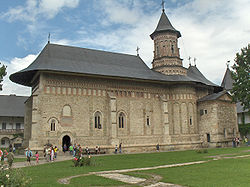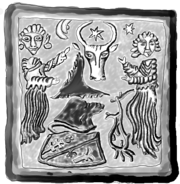
Târgu Neamt
Encyclopedia
Târgu Neamţ is a town in Neamţ County
, Romania
, on the Neamţ River. It had, , a population of 20,496. Three villages are administered by the town: Blebea, Humuleşti and Humuleştii Noi.
, hence its name (in Romanian
"târg
" = market
), it had an important role in Moldavian culture. It was first mentioned in a late-14th century document.
 The name neamţ
The name neamţ
is derived from the Slavic
word nemeti meaning "snows". In many Slavic languages, nemeti also means "German
", as Germans could not understand Slavic speakers when the cultures first met. "Neamţ" is also a generic name for the German people in the Romanian language
. This may lead to speculation of a German foundation of Târgu Neamţ, according to which Saxon colonists crossed the Carpathians from the Bistriţa
area and built a commercial township. Some Romanian historians, including B. P. Haşdeu consider that Târgu Neamţ was probably a Teutonic
settlement from the 13th century, when the Teutonic Order made incursions from Transylvania against the Cumanic
peoples that were living in Moldavia. Nowadays, historians disagree with this possibility mostly because of the long-lasting influences of the communist-nationalistic historiography which refused to accept the town was anything else than a Romanian-founded settlement.
(to the east) and Târgu Mureş to the west.
The railroad station is the terminus station of CFR Line 517
linking it to Paşcani
via an electrified railway.

Neamt County
Neamț is a county of Romania, in the historic region of Moldavia, with the county seat at Piatra Neamț. It has three communes, Bicaz-Chei, Bicazu Ardelean and Dămuc in Transylvania.-Demographics:...
, Romania
Romania
Romania is a country located at the crossroads of Central and Southeastern Europe, on the Lower Danube, within and outside the Carpathian arch, bordering on the Black Sea...
, on the Neamţ River. It had, , a population of 20,496. Three villages are administered by the town: Blebea, Humuleşti and Humuleştii Noi.
History
Originally a market townMarket town
Market town or market right is a legal term, originating in the medieval period, for a European settlement that has the right to host markets, distinguishing it from a village and city...
, hence its name (in Romanian
Romanian language
Romanian Romanian Romanian (or Daco-Romanian; obsolete spellings Rumanian, Roumanian; self-designation: română, limba română ("the Romanian language") or românește (lit. "in Romanian") is a Romance language spoken by around 24 to 28 million people, primarily in Romania and Moldova...
"târg
Târg
A târg was a medieval Romanian market town. The term originates from the Slavic root torg for "trade". Târgs were originally established on the places where periodic fairs were held. With time, they became permanent settlements as craftsmen built their workshops near the place where the fair was held...
" = market
Market
A market is one of many varieties of systems, institutions, procedures, social relations and infrastructures whereby parties engage in exchange. While parties may exchange goods and services by barter, most markets rely on sellers offering their goods or services in exchange for money from buyers...
), it had an important role in Moldavian culture. It was first mentioned in a late-14th century document.

Neamt
Neamţ may refer to several entities in Romania:County* Neamţ CountyPlaces* Neamţ Citadel* Piatra Neamţ* Târgu NeamţMountain* Neamţ MountainsOther* Neamţ Monastery- See also :* Neamţu* Neamţu * Németh...
is derived from the Slavic
Slavic languages
The Slavic languages , a group of closely related languages of the Slavic peoples and a subgroup of Indo-European languages, have speakers in most of Eastern Europe, in much of the Balkans, in parts of Central Europe, and in the northern part of Asia.-Branches:Scholars traditionally divide Slavic...
word nemeti meaning "snows". In many Slavic languages, nemeti also means "German
Germans
The Germans are a Germanic ethnic group native to Central Europe. The English term Germans has referred to the German-speaking population of the Holy Roman Empire since the Late Middle Ages....
", as Germans could not understand Slavic speakers when the cultures first met. "Neamţ" is also a generic name for the German people in the Romanian language
Romanian language
Romanian Romanian Romanian (or Daco-Romanian; obsolete spellings Rumanian, Roumanian; self-designation: română, limba română ("the Romanian language") or românește (lit. "in Romanian") is a Romance language spoken by around 24 to 28 million people, primarily in Romania and Moldova...
. This may lead to speculation of a German foundation of Târgu Neamţ, according to which Saxon colonists crossed the Carpathians from the Bistriţa
Bistrita
Bistrița is the capital city of Bistriţa-Năsăud County, Transylvania, Romania. It is situated on the Bistriţa River. The city has a population of approximately 80,000 inhabitants, and it administers six villages: Ghinda, Sărata, Sigmir, Slătiniţa, Unirea and Viişoara.-History:The earliest sign of...
area and built a commercial township. Some Romanian historians, including B. P. Haşdeu consider that Târgu Neamţ was probably a Teutonic
Teutons
The Teutons or Teutones were mentioned as a Germanic tribe by Greek and Roman authors, notably Strabo and Marcus Velleius Paterculus and normally in close connection with the Cimbri, whose ethnicity is contested between Gauls and Germani...
settlement from the 13th century, when the Teutonic Order made incursions from Transylvania against the Cumanic
Cumans
The Cumans were Turkic nomadic people comprising the western branch of the Cuman-Kipchak confederation. After Mongol invasion , they decided to seek asylum in Hungary, and subsequently to Bulgaria...
peoples that were living in Moldavia. Nowadays, historians disagree with this possibility mostly because of the long-lasting influences of the communist-nationalistic historiography which refused to accept the town was anything else than a Romanian-founded settlement.
Access
The town is located at the crossing of two national roads: and . The planned East-West Motorway will bypass the town on its south when completed, providing access to IaşiIasi
Iași is the second most populous city and a municipality in Romania. Located in the historical Moldavia region, Iași has traditionally been one of the leading centres of Romanian social, cultural, academic and artistic life...
(to the east) and Târgu Mureş to the west.
The railroad station is the terminus station of CFR Line 517
Caile Ferate Române Line 500
Line 500 is one of CFR's main lines in Romania having a total of 488 km and passing through important cities like Bucureşti, Ploieşti, Buzău, Focşani, Adjud, Roman, Paşcani and Suceava.-Secondary lines:...
linking it to Paşcani
Pascani
Paşcani is a city in Iaşi County in the Moldavia region of Romania on the Siret river. , it has a population of 42,172. Five villages are administered by the city: Blăgeşti, Boşteni, Gâsteşti, Lunca and Sodomeni....
via an electrified railway.
Tourism and attractions
- The Neamţ FortressNeamt CitadelNeamţ Citadel is a medieval fortress located in north-eastern part of Romania, near Târgu Neamţ, Neamţ County. It was built in 14th century Moldavia during Petru I of Moldavia's reign and expanded in the 15th century...
(Cetatea Neamţului) was built in the 14th century by Voivode Petru IPetru I of MoldaviaPetru I Muşat was Voivode of Moldavia from 1375 to 1391, the son of Costea Muşat, the first ruler from the dynastic House of Bogdan. During his reign, he maintained good relationships with his neighbours, especially Poland....
(possibly on the ruins of a smaller Teutonic castle), and is located on the north bank of the Neamţ river.

- Târgu Neamţ is an appropriate starting point for trips to the monasteries in the region, located all on an average 15 km radius: Neamţ MonasteryNeamt MonasteryThe Neamţ Monastery is a Romanian Orthodox religious settlement, one of the oldest and most important of its kind in Romania. It was built in 14th century, and it is an example of medieval Moldavian architecture...
, Secu, AgapiaAgapia MonasteryThe Agapia Monastery is a Romanian Orthodox monastery located 9 km west of Târgu Neamţ, in Agapia Commune, Neamţ County. It was built between 1642 and 1647 by Romanian Voivode Vasile Lupu. The church, restored and modified several times during the centuries was painted by Nicolae Grigorescu,...
, Văratec MonasteryVaratec MonasteryVăratec Monastery is a Romanian Orthodox religious settlement located in north-eastern part of the country, in Văratec village, Agapia Commune, Neamţ County.-External links:***...
Sihăstria and Sihla Skete. It is close to Ceahlău, DurăuDurauDurău is a ski resort located in north-eastern Romania, in Neamţ County, Moldavia at the proximity of Ceahlău Massif...
and Valea Bistriţei.
- Ion CreangăIon CreangaIon Creangă was a Moldavian-born Romanian writer, raconteur and schoolteacher. A main figure in 19th century Romanian literature, he is best known for his Childhood Memories volume, his novellas and short stories, and his many anecdotes...
memorial house in Humuleşti, across OzanaOzanaOzana is a genus of moths of the Noctuidae family.-References:*...
river: This is the house where the famous Romanian writer was born and where he spent his childhood. The stories from Ion Creangă's masterpiece Amintiri din copilărie ("Memories of my childhood") revolve around Humuleşti, Târgu Neamţ and in the surrounding villages.
- Monumentul Eroilor (Heroes' Monument): an obelisk that commemorates the Romanian soldiers from World War I is found on Dealul Pleşu near the Pometea suburb. It commands views of the town and the mountains.
- Vânători-Neamţ Natural Park, housing a herd of wisentWisentThe wisent , Bison bonasus, also known as the European bison or European wood bison, is a species of Eurasian bison. It is the heaviest surviving land animal in Europe; a typical wisent is about long, not counting a tail of long, and tall. Weight typically can range from , with an occasional big...
, the European bisons that once roamed the Eastern Carpathians.
- Nicolae Popa ethnographic museum in Târpești
Natives
- Ion CreangăIon CreangaIon Creangă was a Moldavian-born Romanian writer, raconteur and schoolteacher. A main figure in 19th century Romanian literature, he is best known for his Childhood Memories volume, his novellas and short stories, and his many anecdotes...
- Gabriela Istrate
- Irving LaytonIrving LaytonIrving Peter Layton, OC was a Romanian-born Canadian poet. He was known for his "tell it like it is" style which won him a wide following but also made enemies. As T...
- Mariana SimionescuMariana SimionescuMariana Simionescu is a former professional tennis player from Romania. She played on the WTA Tour from 1973 to 1980. She won one WTA tour singes title at the Tokyo Outdoors in 1980. Her best Grand Slam performance was reaching the 4th round at Wimbledon in 1977 and she was ranked as high as 7...
- Metropolitan Varlaam
- Ioan Vieru
- Moshe Idel

